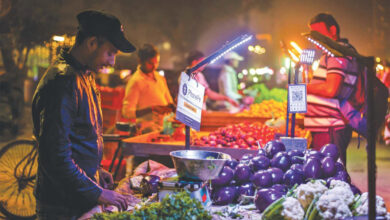Why Nepali students can’t wait to go abroad
Lack of jobs due to political instability and growing corruption have driven thousands of youths to seek their future overseas, experts say.

By Subin Adhikari
Kathmandu: Suraj Chaudhary of Global College of Management, Baneshwar is readying to go abroad for further studies, barely a month after his high school result was published in which he scored an A+.
Chaudhary wants to go to the United States to study information technology (IT). He says the main reason is there are well-paying part-time jobs for students and many career opportunities after graduation.
“My father has been a teacher for the last 30 years, but his salary isn’t enough to support our family of four. Now it’s time to do my part,” said the 18-year-old.
“I can’t find any job that pays well enough in Nepal. If I get a scholarship in the US, at least I can send some money home to support the family.”
Experts say that lack of jobs due to political instability and growing corruption have driven thousands of youths to seek their future overseas.
Political unrest has crippled the country’s economic growth. According to the central bank, the growth rate hovered around a mere 3-4 percent for most of the past decade.

In fiscal 2007-08, growth hit a high of 6 percent following the comprehensive peace accord between the Maoists and the government in 2006.
The country was wracked by severe power shortages in the following years, when Nepalis were forced to live without electricity for 18 hours a day. This continued until 2017.
Then natural calamities and political instability impeded growth. After the earthquake of 2015, Nepal’s growth peaked at an all-time high of 9 percent in 2016 and fell to a record low of -2.4 percent in 2021 due to the Covid pandemic.
Chaudhary, who hails from Rautahat in the Tarai plains, sees no future in Nepal. He has convinced his family to sell a piece of land to pay for his foreign study, which will cost more than Rs1 million.
Chaudhary isn’t the only one who has set their sights abroad. Among his 42 classmates, 18 have started studying for the Scholastic Aptitude Test (SAT), which students wanting to go to college in the US need to pass.
According to the Ministry of Education, 110,217 students obtained a No Objection Certificate (NOC) for foreign study in the last fiscal year ended July 16, a fourfold jump in 10 years.
Australia, Japan, Canada, the United Kingdom and the US, in that order, are the top five destinations for Nepali students.
Of the total number of NOCs issued in the last fiscal year, 33,991 were for Australia, 21,658 for Japan, 21,544 for Canada, 10,527 for the UK and 3,970 for the US, according to the ministry.
The central bank said that Nepalis spent Rs144.46 billion on foreign travel, including Rs100.42 billion for education, in the last fiscal year.
Apart from the student exodus, the number of Nepali migrant workers obtaining approval for foreign employment reached 774,976 in the last fiscal year.
Experts say the number of students going abroad has kept rising given the country’s economic situation, which is estimated to have slowed down by 1.8 percent in the last fiscal year.
Nanda Gurung, president of the Non-Resident Nepali Association (NRNA) Australia Chapter, said the major reason for students rushing abroad is lack of employment opportunities after graduation at home.
“Many developed countries have attractive policies for permanent resident (PR) which is a big draw for Nepalis,” he said.
“Foreign universities offer a flexible schedule for international students, businesses also offer part-time jobs with a good salary that is enough to make the students economically independent. So they are encouraged to come here,” said Gurung.
“Many countries are amending their policies in favour of international students recently.”
The Australian government allowed international students to work up to 24 hours a week effective from July 1 this year.
Before Covid border restrictions were imposed, international students were able to work 20 hours a week while completing their studies. The spouses of postgraduate students can work unlimited hours.
Students say that it’s a one-time investment to go abroad.
Similarly, international students in the US and Canada are permitted to work up to 20 hours a week.
Binita Thapa, who has been studying in Texas, US for two years, told the Post that they generally are paid $13 an hour, which is sufficient to live an independent life.
“But Nepali students usually work overtime in groceries and restaurants. After graduation, they can earn $40-$50 an hour, which is way higher than what you make in any respectable job in Nepal. So, I came to the US right after high school.”
Migrating to a foreign country for further studies is no cakewalk, however. According to Gurung, students are often exploited and cheated during their initial days abroad.
“The newcomers are generally unaware of the basic wage rate, employee rights and labour laws of the host country. So they are often exploited by their employers,” said Gurung.
“The students are also afraid of complaining to the authorities as they fear losing their visa because they’re working longer hours than permitted.”
Salvatore Babones, associate professor at the University of Sydney, defines spending by Nepalis as a “risky investment”.
“An Australian degree—which costs a minimum of approximately AU$25,000 ($16,000) per year, plus living expenses—is not an economical route to job security back in Nepal. Few jobs in Nepal pay so well that they justify spending AU$100,000 or more on an international degree,” Babones told the Post in an email.
“Australia uses Nepali students as a ready pool of low-wage labour, and most students seem to be in Australia primarily in order to obtain access to the Australian labour market. There are effectively no restrictions on their work whatsoever.”
According to the experts, Australia gains two major advantages from international students. The first is that international student fees fund research at Australian universities.
“Australian universities have climbed up the rankings over the last two decades primarily because of research funded by international students. Most Nepali students, however, attend Australian universities that are not particularly research-intensive,” added Babones, who is also the author of the book Australia’s Universities: Can They Reform?
These universities charge relatively lower tuition fees than the research-intensive ones.
The main benefit to Australia from these students is a ready supply of low-wage workers.
They say that the financial pressures on Nepali students are often enormous because many students borrow up-front to satisfy the financial requirements of their Australian visas.
“Inevitably, these students face discrimination in Australia, not primarily because of racism (Australia is a very welcoming country) but because potential employers realise that Nepali students are often desperate for employment. Life is undoubtedly very stressful for these students,” Babones said.
“Both Nepal and the host country’s government are well aware that Nepali students often show forged bank balances to get a visa, but none of the stakeholders is willing to rationalise the procedure as they are benefiting from the existing system.”
Adhikari is a sub-editor at the business desk.


![Mumtaz Zahra Baloch, spokesperson for Pakistan's Foreign Ministry, says the country believes in constructive dialogue with the US [Courtesy of Pakistan Ministry of Foreign Affairs]](https://southasiancorrespondent.com/wp-content/uploads/2024/06/pak-1-390x220.jpg)

